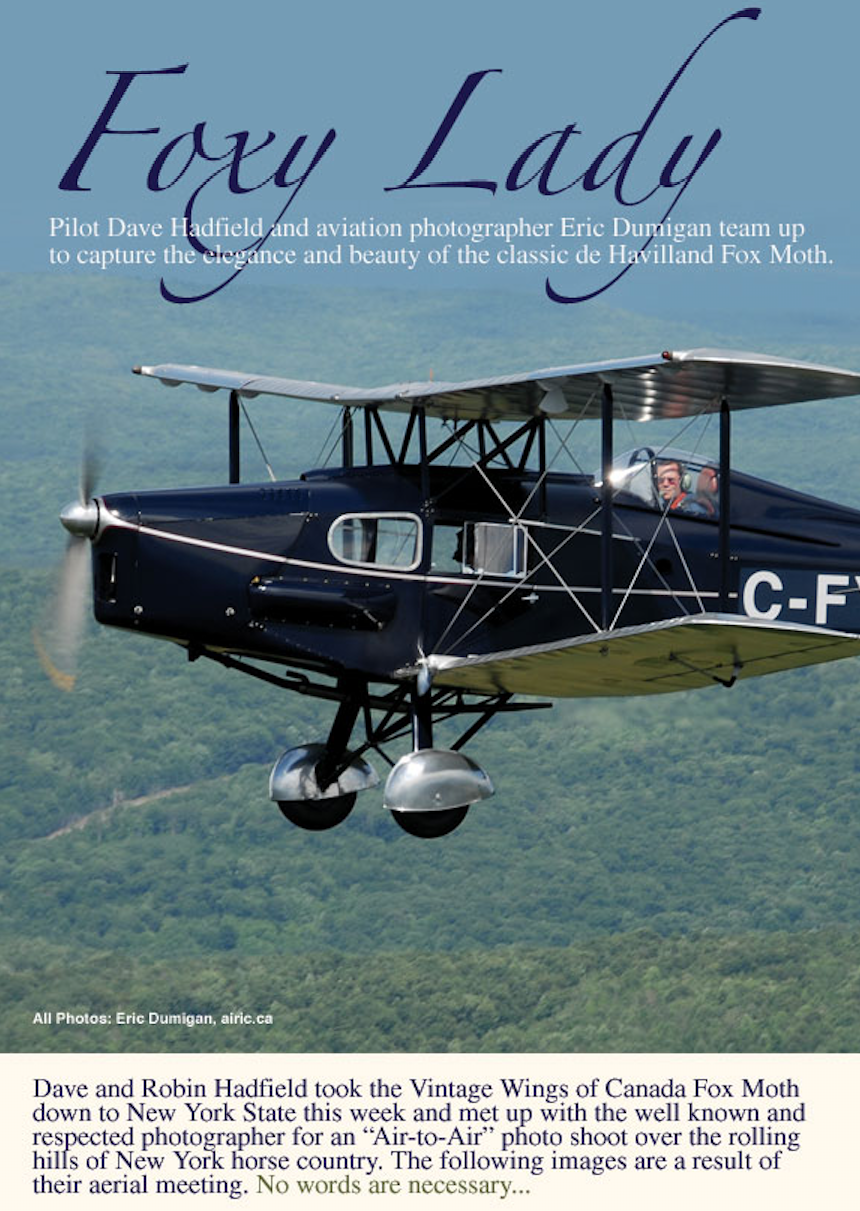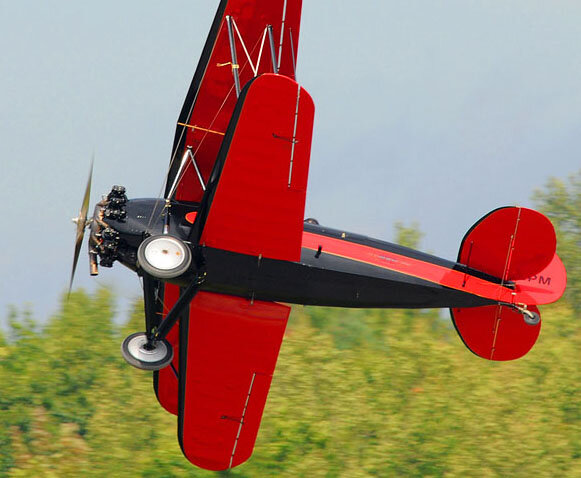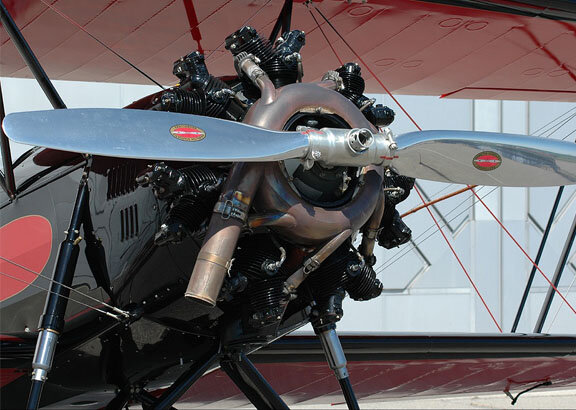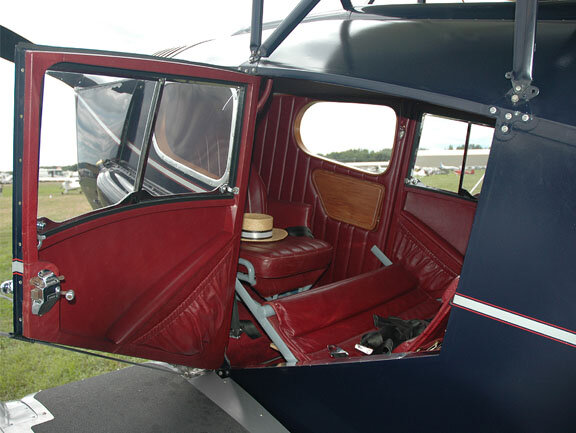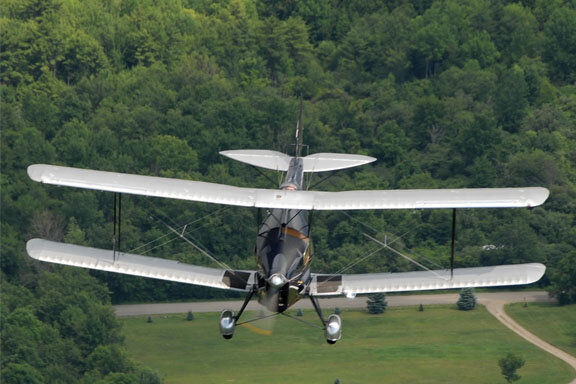A DIFFICULT DECISION
Over the years, the mission of Vintage Wings of Canada has become more defined as the collection has grown from 5 aiplanes to 19. Our focus has clearly become the telling of stories about Canada's aviation heroes, aircraft designs and history. When filtered through this now well-defined mission, two aircraft in the collection stand out in that they have minimal to no Canadian stories to tell.
They are unfortunately two of the most beautiful and historic aircraft of all. The WACO Taperwing and de Havilland Fox Moth are two of the most highly regarded aircraft in our collection. It is testament to their historic significance thast both aircraft have been on display during winter months at the Canada Aviation and Space Museum over the past two years. Crowds flock to see them whenever they are demonstrated by our cadre of highly experienced pilots. The Taperwing now rests in the baggage carousel area at the Ottawa International Airport should fans need one last look at her before her sale.
However, the reluctant and for some very sad decision has been made to let them go from the collection to make room on our over-crowded floor for more Canadian aircraft like our newly acquired Tiger Moth, Cornell and Fleet Finch. In the future there are plans for some very significant acquisitions that will further expand and support our unique Canada-first mission.
Call it what you will - a clearer focus, a culling of the herd, or a "Sophie's Choice", it has been decided after much discussion, that these two remarkable aircraft must make way for Canadian history. They will provide room in the collection for new acquisitions in the future and for the time being give us some breathing space for maintenance on the hangar floor. Serious inquiries can be made to Kevin Forbes at Vintage Wings of Canada - where upon we will offer qualified parties a full set of aircraft specifications, recent work and upgrades, history and features for consideration.
Below, you will find some highlights of the individual histories of both aircraft and photographs that speak to the outstanding beauty of both aerodynamic masterworks.
The WACO Taperwing A.T.O.
A thoroughbred racer and Art Deco masterpiece
Mike Potter, wearing a ball cap and a grin, demonstrates the beauty of flying the open cockpit Taperwing - the wind in the wires, the whiff of hot oil and the absolute freedom of flight at its purest. The lovely art deco masterpiece that is the WACO Taperwing has often been compared to the Bugatti racer - though the lesser Bugatti can only operate in two dimensions. Photo by Parr Yonemoto
In her earlier life, the Vintage Wings of Canada WACO Taperwing A.T.O. was registered NC-8531 and owned by famous air racer Johnny Livingston, perhaps as well known in his day as Mario Andretti was in the 1970s and Michael Schumacher is today. Here we see NC-8531 (the Vintage Wings Taperwing at lower left lined up next to a couple of other Taperwings) at what appears to be an air race, perhaps in the late 1920s, as she was returned to the WACO factory in 1931 to be outfitted with standard wings (A.S.O.). Looking at Livingston's log book, he was flying NC-8531 as late as 1932, so possibly we are looking at an air race where she was flown by him. Livingston would later be the inspiration and indeed namesake behind Richard Bach's strange but best selling novel of the 1970s called Jonathan Livingston Seagull.
The dashing Johnny Livingston was the first owner of the Vintage Wings of Canada Taperwing. Photo: Davis Monthan Aviation Field Register
Related Stories
Click on image
If a future owner of the Taperwing ever wanted proof of her racing heritage, these pages from Livingston's log book (these are back page entries recording his races and earnings and not his standard log book pages) show clearly that in 1929 he was still the owner of NC-8531 and had used her in races across America including Sioux City, Bloomington and Danville. He earned a total of $3,755.00 prize money in our Taperwing in 1929. The entry above the NC-8531 items shows he flew NC-7527 (his most photographed mount) to a first place win of the cross-country New York to Los Angeles Derby where he collected his great reputation and $2,910.00 Livingston's log book is a stunning piece of aviation history, but his log book entries are inconsistent - sometimes he records the aircraft registration and other times not. By the end he was very cryptic and barely recorded anything but date and hours. There are perhaps 77 entries (with clear a indication of the registration) in his log book for NC-8531, the Vintage Wings Taperwing. His third last flight was on the 12th of May 1931 and he did not fly it again until the 22nd of April 1932 and one last time on the 7th of June, 1932 where his aircraft type entry states for the first time that it was a WACO S.W.. Perhaps this means that it was now a Straight or Standard Wing. This would mesh nicely with our history that states its wings were changed to standard continuous chord type in 1931 - clearly initiated by him. Photo: Davis Monthan Aviation Field Register
In her next life, she was painted bright blue and served as a float-equipped joyride aircraft out of Peoria, Illinois. Here we see her, still regsitered as NC-8531, taxiing up to be loaded with excited passengers - quite possibly on Peoria Lake, an expansion of the meandering Illinois River. If this is Peoria, then it is interesting to note that she operated near Ottawa in those days too! - Ottawa, Illinois that is. It is also known that she operated tours from Boston, so perhaps this is Boston Harbor - can't say for sure.
Every passenger who flew aboard the Peoria-based WACO was given a small card as a memento. For her work as a float-equipped passenger aircraft, NC-8531 needed all the lift she could get. To this end, her beautiful tapered wings were replaced in 1931 by a standard continuous chord type which generated more lift. Later, she would run tours from Boston and would do so with these less elegant wings.
Again, I am not sure if this is Boston or Peoria. Regardless, the two white helmeted passengers are about to have the thrill of a life time.
The Vintage Wings of Canada Taperwing continues to be part of popular culture. In 2008, it was the aircraft that Amelia Earhart (played by the Hollywood superstar Hilary Swank) "flew" in an air race called the "Powder Puff Derby". Mike Potter taught Swank how to start the Taperwing so that her scene in it would look more authentic and he flew (with a white avitrix helmet and flying suit) the plane across the finish line at the race with contenders almost catching him/her at the line. A tight race indeed given it was a cross country rally. Photo of Swank in other aircraft via Campbell Harrod
A good shot that tells why it is called a Taperwing.
There is no better way to fly. You can fly faster, higher and farther in other types, but none can compare to the feel of the slipstream in your hair, the thrum of the WACO's wires, the distinctive whistle and thunder of the Wright Whirlwind and the knowledge that you are flying a living piece of history. Photo: Peta Cook
The WACO Taperwing A.T.O. is a true pilot's airplane, one which delivers breath-taking and glorious fun to those pilots whose skill and experience are up to the challenge. One of Vintage Wings of Canada's pilots, Rob Erdos (a test pilot by day) beams from the racy and surprisingly roomy cockpit of the Taperwing. Inset: Her first pilot was Johnny Livingston, air racer, business man and WACO dealer.
The elegant, tailored and smart lines of the Art Deco masterpiece called the WACO Taperwing are clearly evident in this quartering shot from the stern. Photo by Peter Handley
The Taperwing is is known for her speed and history, but her biggest appeal to the general public, (and believe me, owners will inherit an adoring public) is her style. One can imagine how she captivated the Air Race audiences of the 1920s with her rakish and modern lines. Photo by J.P. Bonin
Everything seems to meet at her nose - the gear struts, wing struts, pistons, exhaust stack and propeller all scream speed - and delivered it too. Photo by J.P. Bonin
Flying the WACO Taperwing, or being squired around in her passenger seat (accommodating two) is an experience for all the senses - the sound of the Whirlwind, the smell of warm oil, the feel of the wind in your hair, the view all around you and the unmistakable good taste shown by the very airplane you own. Photo by Mike Henniger
The De Havilland DH-83 Fox Moth.
A rich 75-year history on both sides of the earth.
The Vintage Wings of Canada de Havilland Fox Moth is arguably the finest example still flying and has without question the richest history of all Fox Moths ever built. Here Dave Hadfield (soon to be the saddest pilot at Vintage Wings after the sale of the Fox Moth and Taperwing) floats in lovely and delicate style over the lush green hills of the Adirondacks. Photo by Eric Dumigan
You won't need and frankly, won't want a paved air strip for Fox Moth operations. While perfectly at home on macadam, this baby was meant for grass. From her chrome wheel spats to her silver cheatlines and that lovely fish-like tail, she is the epitome of British style and design - perhaps that is why The Prince of Wales (Edward XIII) selected her to be one of the first aircraft to squire the Royal Family about from castle to estate to hunting grounds. Photo J.P Bonin
In earlier service, the Fox Moth sported a highly polished aluminium engine cowling. Originally built for the Prince of Wales by the de Havilland Aircraft Co. at Stag Lane, England she was assigned construction number 4033. The aircraft was registered as G-ACAJ by Flt. Lt. E. H. Fieldon for HRH the Prince of Wales in November. This was altered to G-ACDD a month later. The aircraft was operated by the Royal Flight until June 1933.
The VWC Fox Moth was a prefect specimin of one of the great de Havilland designs. Her beauty and elegant paint made her the poster child for de Havilland advertisements of the day. Posssibly, de Havilland was going through some difficulties in 1934 as witnessed by the reduction in price meant to move Fox Moth aircraft.
After her brief but regal employment with the British Royal Family, G-ACDD was purchased by Belgian national Mr. Guy Hansez-Fester and re-registered as OO-ENC. Later in March and April of 1934, Hansez-Fester flew her from Antwerp to the Belgian Congo in only 5 days and returned in 8 days. Photo: Antwerp Avaition Society Coll. Dirk Buyaert (L'Aviation Illustrée, 05, 1934)
When Vintage Wings of Canada took receipt of the Fox Moth, we found in her cabin an album of photographs chronicaling her accident and operations in New Zealand. The following images were part of that album. After her newsworthy flight to the Belgian Congo, she continued to fly with Hansez-Fester until 1935 when she was sold back to de Havilland and then on to Air Travel of New Zealand where she made her way by ship. In New Zealand she was re-registered as ZK-AEK and immediately embarked on her new career on the first scheduled airline service in that country. Her paint looks somewhat the same but with the tail painted a light colour - possibly silver. Her wheel spats have been removed by this time, perhaps to better deal with the rough airfields she would operate from.
In the rough New Zealand geography, ZK-AEK would utilize what ever landing facilities she could find including beaches and sand bars. Here children make sand castles (perhaps for her Royal Family roots) with the beautiful Fox Moth as a back drop.
Contrasting the new and old. ZK-AEK overflies a frontier postman and his pack horse, demonstrating the new way in which mail could be delivered.
A lovely photograph of ZK-AEK in front of her home at Air Travel, in Hokitika. Air Travel (NZ) Ltd was the first airline in New Zealand to fly scheduled air services. Founded by Bert Mercer in 1934, and based in Hokitika, the company flew a number of De Havilland biplane aircraft, servicing areas on the West Coast. Mercer saw the potential for a commercial air service in this region because with no roads south of Ross residents relied on steamers and bullock tracks for access to the outside world. Such was her importance in the early days, that the company used her silhouette as their logo. This can be seen on the hangar above the doors. The company also operated Dragonfly, Dragon and Dragon Rapide aircraft - one of which can just be seen to the left.
ZK-AEK had a major setback in 1943 when it crashed on the Franz Josef Glacier in October of 1943. There were no serious injuries to pilot and passengers. Here we see a photo of ZK-AEK (clearly identified by the letters on the wing) and this is where I begin to get confused. The aircraft appears to have the dark fuselage and light silver wings of her first paint scheme. Now on to the next photo...
Now, we see a photo of ZK-AEK being taken down the glacier by a salvage crew and her paint seems to have miraculously turned to a light colour with dark lettering. Perhaps it is that weird effect that ortho-chromatic film had on prints making certain colours darker than they would normally be. But this different?
The salvage crew rests on the way down and now the paint looks dark again without evidence at all of her large registration on the side.
Attached to a sledge, ZK-AEK is man-handled down some pretty precipitous slopes. Again, the aircraft seems to be in the dark paint with just a faint, faint indication of a registration. Strange.
It is impossible to tell the actual sequence the above photographs were taken in, but this one seems lower down with the trees and bush on the hills in the background. The weird thing is that now it seems to be a silver aircraft with dark markings. Perhaps it is an extreme case of ortho-chromatic colour shift but I would think the photographer would have used the same film all the way down the slope. Perhaps there were two shooters.
Now down in the moraine field below Franz Josef Glacier, the salvage crew cannot use a sledge and the fuselage had to be carried by hand. If this is an ortho-chromatic shift, then I believe that the Fox Moth was, by 1943, a light coloured aircraft with dark markings as the images that seem to show a dark fuselage do not bear contrasting white registration letters.
At the bottom of the moraine field, ZK-AEK was floated on two skiffs/canoes for a paddle across the glacial lake. If the man at the right is carrying a camera , then indeed there was more than two cameras with this fellow likely having the ortho-graphic film.
A smaller group of salvors paddle the unlikely raft across the glacial waters of the fijord which empties into the Tasman Sea.
At the bottom of Franz Josef Glacier, the fuselage is lifted onto an awaiting lorry for transport to the Hokitika maintenance facility. It is a testament to the importance of ZK-AEK to the continuing air operations at Air Travel that such an effort was made to retrieve her. Getting a new Fox Moth would have meant many more months of delay. She was returned to service in May of 1944 - only 7 months after her crash.
ZK-AEK many years after her difficult salvage warming up in 1952.
Dave Hadfield brings the Fox Moth in for a close-up. The fine finish, exquisite detailing and enclosed passenger cabin are all very evident in this shot. Photo by Eric Dumigan
The Stagg Lane-built de Havilland Fox Moth's heritage cannot be connected to Canada. Her history lies somewhere between Great Britain, Belgium and New Zealand. It is rich and storied and colourful... unfortunately it is not Canadian. Photo: Eric Dumigan
Your passengers will fly like kings - literally! The rich maroon leather interior and wood inlay speak to the quality of the original aircraft and the restoration work. Photo J.P. Bonin
The elegantly simple cockpit of the Fox Moth. By using the speaking tunnel (the mirror like glass door at top), the Prince's pilot could speak directly to him and perhaps be passed a cup of tea. Photo J.P. Bonin
The Stagg Lane-built de Havilland Fox Moth's heritage may not be connected to Canada, but it is as rich as any vintage aircraft in the world today. Her history lies somewhere between Great Britain, Belgium, Congo, New Zealand and her future. It is rich and storied and colourful... unfortunately it is not Canadian. Whoever is lucky enough to be her next owner will delight in her continuing story, her wonderful handling characteristics and flying experiences that will bring memories and joy for the rest of their lives. Photo by J.P. Bonin






